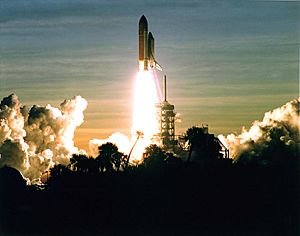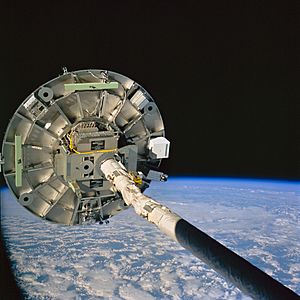STS-60 facts for kids
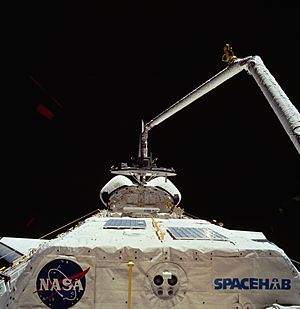
The SPACEHAB-2 in Discovery's payload bay, as Canadarm grapples the Wake Shield Facility (WSF-1).
|
|
| Mission type | Microgravity research |
|---|---|
| Operator | NASA |
| Mission duration | 8 days, 7 hours, 9 minutes, 22 seconds |
| Distance travelled | 5,535,667 km (3,439,704 mi) |
| Orbits completed | 130 |
| Spacecraft properties | |
| Spacecraft | Space Shuttle Discovery |
| Landing mass | 97,448 kg (214,836 lb) |
| Payload mass | 10,231 kg (22,555 lb) |
| Crew | |
| Crew size | 6 |
| Members |
|
| Start of mission | |
| Launch date | 3 February 1994, 12:10:00 UTC |
| Rocket | Space Shuttle Discovery |
| Launch site | Kennedy Space Center, LC-39A |
| Contractor | Rockwell International |
| End of mission | |
| Landing date | 11 February 1994, 19:19:22 UTC |
| Landing site | Kennedy Space Center, SLF Runway 15 |
| Orbital parameters | |
| Reference system | Geocentric orbit |
| Regime | Low Earth orbit |
| Perigee | 348 km (216 mi) |
| Apogee | 351 km (218 mi) |
| Inclination | 56.40° |
| Period | 91.50 minutes |
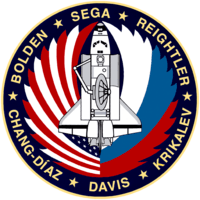 STS-60 mission patch 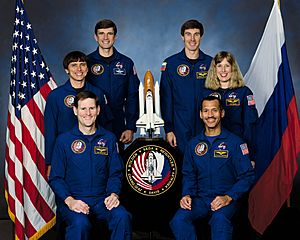 Clockwise from bottom left: Kenneth S. Reightler Jr., Franklin R. Chang-Díaz, Ronald M. Sega, Sergei K. Krikalev, N. Jan Davis, Charles F. Bolden Jr. |
|
STS-60 was a very important space mission. It was the first time the United States and Russia worked together on the Shuttle-Mir Program. This mission made history by carrying Sergei Krikalev, the first Russian cosmonaut, aboard a Space Shuttle.
The mission used NASA's Space Shuttle Discovery. It launched from Kennedy Space Center in Florida on February 3, 1994. On board, Discovery carried a special experiment called the Wake Shield Facility and a SPACEHAB module. The crew also talked live with cosmonauts on the Russian space station Mir.
Contents
Meet the Crew
| Position | Astronaut | |
|---|---|---|
| Commander | Fourth and last spaceflight |
|
| Pilot | Second and last spaceflight |
|
| Mission Specialist 1 | Second spaceflight |
|
| Mission Specialist 2 | First spaceflight |
|
| Mission Specialist 3 | Fourth spaceflight |
|
| Mission Specialist 4 | Third spaceflight |
|
The STS-60 crew had six members. Charles F. Bolden Jr. was the mission commander. Kenneth S. Reightler Jr. was the pilot. The mission specialists were N. Jan Davis, Ronald M. Sega, Franklin R. Chang-Díaz, and Sergei K. Krikalev. Sergei Krikalev was a Russian cosmonaut, making this a truly international crew.
Mission Highlights
After Discovery launched, its main engines shut off. Then, small engines fired to put the shuttle into a perfect orbit. The crew quickly opened the cargo bay doors. They started working on the experiments inside the SPACEHAB module.
Experiments in Space
The SPACEHAB module was like a small laboratory in space. It held many experiments. One experiment, called Organic Separations, looked at how to separate cells. This could help make new medicines. Another experiment, ECLiPSE, studied how to make stronger metals. These metals could be used in tools and electronics.
Other experiments looked at how space affects living things. Immune-1 studied the immune systems of rats in orbit. The Commercial Protein Crystal Growth package tried to grow large, perfect protein crystals. Scientists study these crystals to understand how proteins work.
Wake Shield Facility Challenges
A big part of the mission was to deploy the Wake Shield Facility (WSF). This was a special satellite designed to create a super-clean vacuum in space. This vacuum would help grow very thin films for electronics.
However, deploying the WSF was tricky. On February 5, 1994, the crew had trouble seeing the WSF's status lights. There was also radio interference. This caused a delay in releasing it.
The next day, more problems came up with the WSF's sensors. Astronaut Jan Davis tried to fix it using the Canadarm, a robotic arm. Because of these issues, the WSF was never released to fly on its own. Instead, it stayed attached to the Canadarm. Even so, it was able to grow two thin films of Gallium arsenide.
Communicating with Mir
On February 8, 1994, something exciting happened. The Discovery crew had a live video and audio chat with three cosmonauts on the Russian Mir Space Station. This was a big moment for space cooperation between the U.S. and Russia. It showed how countries could work together in space.
Preparing for Landing
As the mission neared its end, the astronauts prepared Discovery for its return to Earth. They checked all the shuttle's systems. They also packed away experiments and other items in the cabin.
On February 9, the BREMSAT satellite was released from Discovery. This small satellite was part of another experiment. Finally, on February 11, 1994, Discovery landed safely back at the Kennedy Space Center. The mission lasted over 8 days and completed 130 orbits around Earth.


